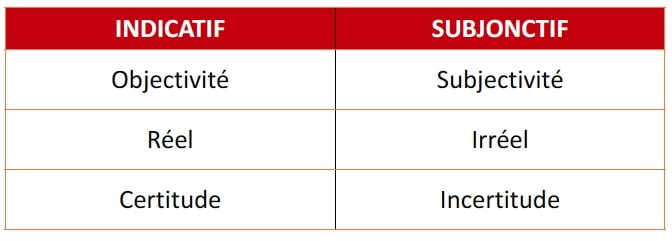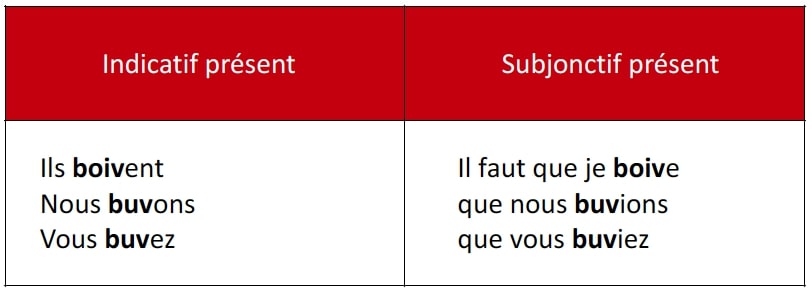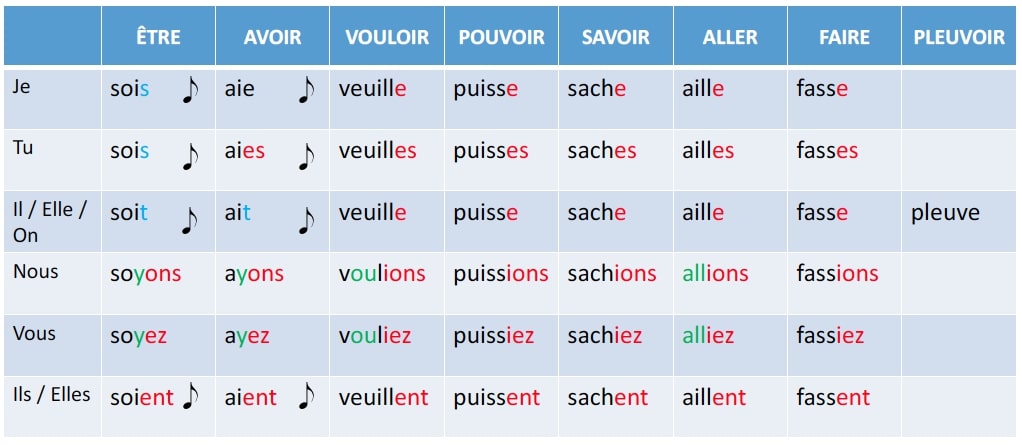Subjunctive vs. indicative in French: What are the differences?

So you have reached level B1 in French? Bravo! You are now going into a very strange world: the subjunctive! What’s the subjunctive in French vs. the indicative? What’s it for? When to use it? What does it look like? And what are the notable differences from the indicative? Read the following and the subjunctive will hold no more secrets for you!
What is the French subjunctive?
That’s the first question to ask yourself! Like the indicative, the subjunctive is a mode, and like the indicative, a mode contains several tenses. Usually in A1, we start with the present tense of the indicative, then the past tense (of the indicative), the imperfect tense of the indicative… Except that we don’t always specify that it is the indicative “mode”.
In the subjunctive, there are three tenses – present, imperfect and more-than-perfect – but to reassure you from the outset, only the present tense of the subjunctive is used. You can find the other tenses of the subjunctive only in 19th-century literature.
What is the subjunctive for?
It is opposed to the indicative:

Unlike the indicative in French which expresses a reality – a certainty, the subjunctive evokes the unreal or subjectivity. It is used to express:
- a wish: “J’aimerais qu’il fasse plus chaud !” (“I wish it was hotter!”)
- a fear: “J’ai peur qu’il perde.” (“I’m afraid he’ll lose.”)
- a doubt: “Je doute qu’il arrive à l’heure.” (“I doubt he’ll be on time.”)
- a regret: “Je suis désolé que tu voies ça.” (“I’m sorry you had to see that.”)
- an opinion: “Je ne crois pas qu’il ait raison.” (“I don’t think he’s right.”)
- a feeling: “Je suis contente que tu sois là.” (“I’m glad you’re here.”)
- a refusal: “Je refuse qu’il s’en aille.” (“I don’t want him to go.”)
- an obligation: “Il faut que je travaille samedi.” (“I have to work on Saturday.”)
- advice: “Il vaudrait mieux que tu dormes.” (“It would be better if you slept.”)
- a proposal: “Je te propose qu’on boive un verre pour fêter ça !” (“I suggest we have a drink to celebrate!”)
It’s also used with certain phrases followed by “que”:
- Il/C’est + adjective + que : “C’est dommage que tu sois en retard.” (“It’s too bad you’re late.”)
- Pour que : “Il révise ses cours pour qu’il puisse réussir son examen.” (“He’s studying his lessons so he can pass his test.”)
- Avant que : “Il a tout nettoyé avant que je vienne chez lui.” (“He cleaned up before I came to his house.”)
- Bien que: “Bien qu’il pleuve, je vais me promener.” (“Although it’s raining, I’m going for a walk.” )
When not to use the subjunctive?
To express affirmation or certainty with “objective” verbs, use the indicative :
- Je constate que, j’observe que, je remarque que… (I notice that)
- Je crois que, je pense que, je suppose que, j’imagine que… (I think that)
- J’affirme que, je déclare que, je dis que… (I say that)
- “Je trouve que vous êtes courageux d’apprendre le français.” (“I think you’re brave to learn French.”) (present tense)
When using the verb “espérer”, the indicative should also be used:
- “J’espère qu’il fera beau demain.” (futur de l’indicatif) (“I hope the weather will be nice tomorrow.”)
How to form the subjunctive in French
As you will see, the French indicative and the subjunctive are intimately linked by their formation. Here is a simple recipe, conjugation is like a Lego game:
– Think of the ” ils/elles ” (3rd person plural) in the present tense of the indicative.
– Remove the ending “-ent” and you get the base of the subjunctive!
– Add the endings :

Example : LIRE (to read) > Ils lisent > lis- > que je lise, que tu lises, qu’il lise, que nous lisions, que vous lisiez, qu’elles lisent.
When “nous” and “vous” have a different root from “ils” in the present tense, they keep this difference in the subjunctive tense:

Regular verbs in French:
The musical notes mean that the pronunciation is the same, despite the different endings.
The present subjunctive of -ER verbs differs very little from the present tense of the indicative, or it looks like imperfect (for the “nous” and the “vous”), that’s why you may never have noticed it before!
Irregular verbs:

For pronunciation, keep in mind that the 1st, 2nd, 3rd person singular and 3rd person plural always have the same pronunciation (even when not indicated by the musical note).
Beware of the negation!
When verbs that express certainty (indicative) are used with negation, it becomes a doubt: the subjunctive is used.
- “Je pense qu’il fait beau, je ne pense pas qu’il pleuve.” (“I think it’s sunny, I don’t think it’s raining.”)
- “Je crois qu’il vient à ton apéritif dînatoire, mais je ne crois pas qu’il vienne avec une bouteille de champagne.” (“I think he’s coming to your aperitif dinner, but I don’t think he’s coming with a bottle of champagne.”)
The future of the French subjunctive
If it can reassure you, the subjunctive is an unloved and mistreated mode, much to the displeasure of the Académie française, which is trying to save it at all costs. In some sentences, the subjunctive can seem a bit pedantic and thus create a social gap.
In the North of France, the Ch’tis – a French dialect and huge success in the cinema – hardly use the subjunctive, they replace it with the indicative.
For the rest of France, either the subjunctive disappears or it is distorted as with the verbs “voir” (“to see”) and “croire” (“to believe”) (correct form in brackets):
- “Il faut que je voye (voie)”
- “Il faut qu’ils croivent (croient)”
If you want to have fun with it, you can listen to the Odelaf song “Le Subjonctif” that plays with the tenses by not conjugating them very well.
And if you want to save the subjunctive, you can read the novel – very accessible at level B1 – by Erik Orsenna (a member of the French Academy) Les chevaliers du subjonctif (2004) which poetically states that: “Le subjonctif est le mode du doute et de l’espérance. Le subjonctif est le mode de l’amour.” (“The subjunctive is the mode of doubt and hope. The subjunctive is the mode of love.”)
And as Master Yoda would say to Luke Skywalker in French: “Que la force soit avec vous !” (“May the force be with you!”)










